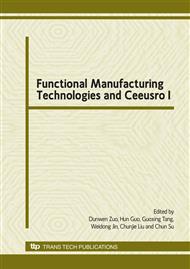p.114
p.118
p.122
p.127
p.132
p.137
p.142
p.147
p.151
The Linear Programming Approach to Clamping Forces Determination with the Frictional Consideration
Abstract:
In machining process, the workpiece is subject to cutting forces and torques. To resist these external loads, a fixture can supply clamping forces to completely restrain the workpiece. However, insufficient clamping forces cannot prevent the workpiece from translation and rotations, whereas excessive clamping forces may cause strongly the improper workpiece-fixture system deformations. Therefore, how to effectively determine the optimum clamping forces is the main objective of this paper. Firstly, a mechanistic model is proposed to measure the stability of clamping forces against these external loads. Secondly, a relaxation method is further established to true obtain the optimum clamping forces by solving the proposed model. The presented approach is conceptually simple and computationally efficient. It is particularly useful in the early stages of fixture design and process planning.
Info:
Periodical:
Pages:
132-136
Citation:
Online since:
January 2010
Authors:
Keywords:
Price:
Сopyright:
© 2010 Trans Tech Publications Ltd. All Rights Reserved
Share:
Citation:


